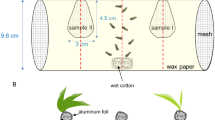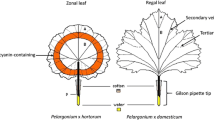Abstract
The effects of phenolic glucosides on the oviposition behavior ofEuura amerinae L. (Hymenoptera: Tenthredinidae) were tested in multiple oviposition experiments using different shoot length categories ofSalix pentandra L. (with different amounts of phenolic glucosides) and in experiments with pure phenolic glucosides (salidroside, arbutin, salicin, 90% salicortin, 90% 2′-O-acetylsalicortin) or composite total fractions of phenolic glucosides from three willow species (S. pentandra, S. myrsinifolia Salisb.,S. triandra L.). This was the first time that the effects of pure phenolic glucosides on the oviposition behavior of sawfly species were tested. Total fraction of phenolic glucosides fromS. pentandra and its main individual glucoside, 2′-O-acetyl-salicortin, stimulated the strongest ovipositional behavior inE. amerinae. The results show clearly that females ofE. amerinae can recognize and choose their host willow,S. pentandra, on the basis of phenolic glucosides. Moreover, they are probably able to use phenolic glucosides as a cue in shoot selection within host-plant individuals.
Similar content being viewed by others
References
Benson, R.B. 1958. Handbooks for the Identification of British Insects, Vol. VI, Part 2(c). Royal Entomological Society of London, London.
Conover, W.J. 1980. Practical Nonparametric Statistics. Wiley, New York.
Craig, T.P., Price, P.W., andItami, J.K. 1986. Resource regulation by a stem-galling sawfly on the arroyo willow.Ecology 67:419–425.
Craig, T.P., Itami, J.K., andPrice, P.W. 1989. A strong relationship between oviposition preference and larval performance in a shoot-galling sawfly.Ecology 70:1691–1699.
Edwards, W.R.N. 1978. Effect of salicin content on palatability ofPopulus foliage to opossum (Trichosurnus vulpecula).N.Z. J. Sci. 21:103–106.
Feeny, P. 1991. Chemical constraints on the evolution of swallowtail butterflies, pp. 315–340,in P.W. Price, T.M. Lewinsohn, G.W. Fernandes, and W.W. Benson (ed.). Plant-Animal Interactions: Evolutionary Ecology in Tropical and Temperate Regions. Wiley, New York.
Fraenkel, G.S. 1959. The raison d'etre of secondary plant substances.Science 129:1466–1470.
Fritz, R.S., andPrice, P.W. 1988. Genetic variation among plants and insect community structure: Willows and sawflies.Ecology 69:845–856.
Fritz, R.S., Sacchi, C.F., andPrice, P.W. 1986. Competition versus host plant phenotype in species composition: willow sawflies.Ecology 67:1608–1618.
Fritz, R.S., Gaud, C.F., Sacchi, C.F., andPrice, P.W. 1987. Variation in herbivore density among host plants and its consequences for community structure: Field studies on willow sawflies.Oecologia 73:159–169.
Futuyma, D.J. 1983a. Selective factors in the evolution of host choice by phytophagous insects, pp. 227–244,in S. Ahmad (ed.). Herbivorous Insects: Host-Seeking Behaviour and Mechanisms. Academic press, New York.
Futuyma, D.J. 1983b. Evolutionary interactions among herbivorous insects and plants, pp. 207–231.in D.J. Futuyma and M. Slatkin (eds.). Coevolution, Sinauer, Sunderland.
Futuyma, D.J., Cort, R.P., andNoordwijk, I. 1984. Adaptation to host plants in the fall cankerworm (Alsophila pometaria) and its bearing on the evolution of host affiliation in phytophagous insects.Am. Nat. 123:287–296.
Gauld, I., andBolton, B. 1988. The Hymenoptera. Oxford University Press, Oxford.
Hämet-Ahti, L., andKyövuori, I. 1984. Salicaceae, pp. 159–172,in L. Hämet-Ahti, J. Suominen, T. Ulvinen, P. Uotila, and S. Vuokko (eds.). Retkeilykasvio. Suomen Luonnonsuojelun Tuki Oy, Helsinki.
Julkunen-Tiitto, R. 1985. Phenolic constituents in the leaves of northern willows: methods for the analysis of certain phenolics.J. Agric. Food Chem. 33:213–217.
Julkunen-Tiitto, R. 1986. A chemotaxonomic survey of phenolics in leaves of northern Salicaceae species.Phytochemistry 25:663–667.
Julkunen-Tiitto, T. 1989A. Phenolic constituents ofSalix: A chemotaxonomic survey of further Finnish species.Phytochemistry 28:2115–2125.
Julkunen-Tiitto, R. 1989b. Distribution of certain phenolics inSalix species (Salicaceae). PhD thesis. University of Joensuu, Joensuu.
Kelly, M.T., andCurry, J.P. 1991. The influence of phenolic compounds on the suitability of threeSalix species as hosts for the willow beetlePhratora vulgatissima.Entomol. Exp. Appl. 61:25–32.
Kolehmainen, J., Julkunen-Tiitto, R., Roininen, H., andTahvanainen, J. 1994. Phenolic glucosides as feeding cues for willow-feeding leaf beetles.Entomol. Exp. Appl. Submitted.
Lindroth, R.L. 1991. Differential toxicity of plant allelo-chemicals to insects, roles of enzymatic detoxication systems. pp. 1–33,in E. Bernays (ed.). Insect-Plant Interactions, Vol. III. CRC Press, Boca Raton, Florida.
Lindroth, R.L., Scriber, J.M., andHsia, M.T.S. 1988. Chemical ecology of tiger swallowtail: Mediation of host use by phenolic glycosides.Ecology 69:814–822.
Markham, K.R. 1971. A chemotaxonomic approach to the selection of opossum resistant willows and poplars for use in soil conservation.N.Z.J. Sci. 14:179–186.
Matsuda, K., andMatsuo, H. 1985. A flavonoid, luteolin-7-glucoside, as well as salicin and populin, stimulating the feeding of leaf beetles attacking salicaceous plants.Appl. Entomol. Zool. 20:305–313.
Palo, R.T. 1984. Distribution of birch (Betula spp.), willow (Salix spp.), and poplar (Populus spp.) secondary metabolites and their potential role as chemical defense against herbivores.J. Chem. Ecol. 10:499–520.
Palo, R.T., Pehrson, Å., andKnutsson, P. 1984. Can birch phenolics be of importance in the defense against browsing vertebrates?Finn. Game Res. 412:75–80.
Pasteels, J.M., Braekman, J.C., andDaloze, D. 1988a. Chemical defense in the Chrysomelidae, pp. 233–252,in P. Jolivet, E. Petitpierre, and T.H. Hsiao (eds.). Biology of Chrysomelidae. Kluwer, Dordrecht.
Pasteels, J.M., Rowell-Rahier, M., andRaupp, M.J. 1988b. Plant-derived defense in chrysomelid beetles, pp. 235–272,in P. Barbosa and D.K. Letourneau (eds.). Novel Aspects of Insect-Plant Interactions. Wiley, New York.
Price, P.W., Roininen, H., andTahvanainen, J. 1987a. Plant age and attack by the bud galler,Euura mucronata.Oecologia 73:334–337.
Price, P.W., Roininen, H., andTahvanainen, J. 1987b. Why does the bud-galling sawfly,Euura mucronata, attack long shoots?Oecologia 74:1–6.
Pschorn-Walcher, H. 1982. Unterordnung Symphyta: Pflanzenwespen, pp. 4–196,in W. Schwenke (ed.). Die Forstschädlinge Europas, 4. Band: Hautflügler und Zweiflügler. Parey, Hamburg.
Rank, N.E. 1992. Host plant preference based on salicylate chemistry in a willow leaf beetle (Chrysomela aeneicollis).Oecologia 90:95–101.
Roininen, H. 1991. Temporal change in the location of egg-laying by a bud-galling sawfly,Euura mucronata, on growing shoots ofSalix cinerea.Oecologia 87:265–269.
Roininen, H., andTahvanainen, J. 1989. Host selection and larval performance of two willow-feeding sawflies.Ecology 70:129–136.
Roininen, H., Vuorinen, J., Tahvanainen, J., andJulkunen-Tiitto, R. 1992. Host preference and allozyme differentiation in shoot galling sawfly,Euura atra.Evolution 47:300–308.
Rowell-Rahier, M. 1984a. The presence or absence of phenolglycosides inSalix (Salicaceae) leaves and the level of dietary specilisation of some of their herbivorous insects.Oecologia 62:26–30.
Rowell-Rahier, M. 1984b. The food plant preferences ofPhratora vitellinae (Coleoptera: Chrysomelidae): A. Field observations.Oecologia 64:369–374.
Rowell-Rahier, M. 1984c. The food plant preferences ofPhratora vitellinae (Coleoptera: Chrysomelidae): B. A laboratory comparison of geographically isolated populations and experiments on conditioning.Oecologia 64:375–380.
Rowell-Rahier, M., andPasteels, J.M. 1982. The significance of salicin for aSalix-feeder,Phratora (Phyllodecta) vitellinae, pp. 73–79,in J.H. Visser and A.K. Minks (eds.). Insect-Plant Relationships. Proceedings, 5th International Symposium on Insect-Plant Relationships, Wageningen.
Rowell-Rahier, M., andPasteels, J.M. 1986. Economics of chemical defense in Chrysomelinae,J. Chem. Ecol. 12:1189–1203.
Rowell-Rahier, M., Soetens, P., andPasteels, J.M. 1987. Influence of phenolglucosides on the distribution of herbivores on willows, pp. 91–95,in V. Labeyrie, G. Fabres and D. Lachaise (eds.). Insects-Plant Relationship. Proceedings, 6th International Symposium on Insect-Plant Relationships, Wageningen.
Smiley, J.T., Horn, J.M., andRank, N.E. 1985. Ecological effects of salicin at three trophic levels: New problems from old adaptations.Science 229:649–651.
Soetens, P., Rowell-Rahier, M., andPasteels, J.M. 1991. Influence of phenolglucosides and trichome density on the distribution of insect herbivores on willows.Entomol. Exp. Appl. 59:175–187.
Sokal, R.R., andRohlf, J. 1981. Biometry: The Principles and Practice of Statistics in Biological Research. Freeman, San Francisco.
Swain, T. 1979. Phenolics in the environment, pp. 617–640,in T. Swain, J.B. Harborne, and J.F. Van Sumere (eds.). Biochemistry of Plant Phenolics. Plenum Press, New York.
Tahvanainen, J., Helle, H., Julkunen-Tiitto, R., andLavola, A. 1985a. Phenolic compounds of willow bark as deterrents against feeding by mountain hare.Oecologia 65:319–323.
Tahvanainen, J., Julkunen-Tiitto, R., andKettunen, J. 1985b. Phenolic glycosides govern the food selection pattern of willow feeding leaf beetles.Oecologia 67:52–56.
Vickery, M.L., andVickery, B. 1981. Secondary Plant Metabolism. Macmillan Press, Hong Kong.
Vikberg, V. 1970. The genusPontania O. Costa (Hymenoptera, Tenthredinidae) in the Kilpisjärvi district, Finnish Lapland.Ann. Entomol. Fenn. 36:10–23.
Waring, G.L., andPrice, P.W. 1988. Consequences of host plant chemical and physical variability to an associated herbivore.Ecol. Res. 3:205–216.
Author information
Authors and Affiliations
Rights and permissions
About this article
Cite this article
Kolehmainen, J., Roininen, H., Julkunen-Tiitto, R. et al. Importance of phenolic glucosides in host selection of shoot galling sawfly,Euura amerinae, onSalix pentandra . J Chem Ecol 20, 2455–2466 (1994). https://doi.org/10.1007/BF02033213
Received:
Accepted:
Issue Date:
DOI: https://doi.org/10.1007/BF02033213




